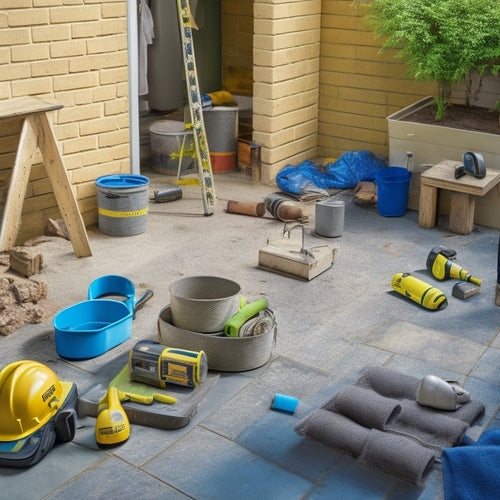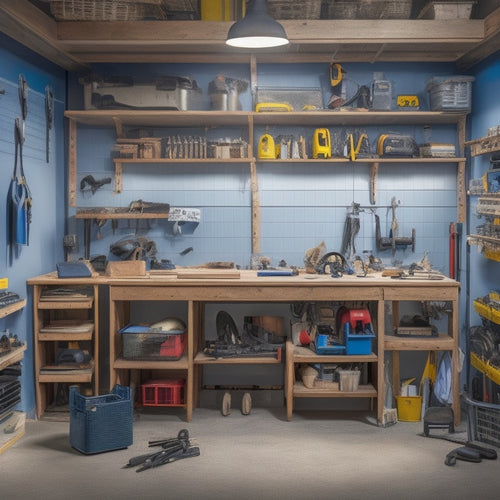
Tool Maintenance Safety Checks for Home Renovations
Share
As you prepare for your home renovation project, remember that tool maintenance safety checks are vital to prevent accidents and injuries. Start by ensuring you have essential safety gear like goggles, gloves, and a dust mask that fit properly and are used correctly. Regularly inspect your tools, especially concrete mixers, to identify signs of wear, rust, or damage. Develop a schedule to track inspections and maintenance, and implement hazard prevention strategies like risk assessments and safety training. By prioritizing tool maintenance, you'll reduce downtime, increase productivity, and create a safer work environment - and that's just the foundation of a successful renovation project.
Key Takeaways
• Conduct regular safety checks on tools every three months to ensure proper function and identify potential hazards.
• Inspect tools for signs of wear, rust, or damage, and perform maintenance tasks as recommended by the manufacturer.
• Develop a maintenance log to track inspections, note any issues or repairs, and identify patterns of recurring problems.
• Ensure all electrical components meet safety standards, and properly store tools in a designated area to prevent accidents.
• Familiarize yourself with specific maintenance routines for different tool types and follow safety training to reduce the risk of injuries.
Essential Safety Gear Checklist
Wearing the right personal protective equipment (PPE) is crucial, so make certain you have the following essential safety gear before starting tool maintenance: safety goggles, protective gloves, and a dust mask.
You'll need these items to shield yourself from flying debris, chemical splashes, and other hazards. Safety goggles will protect your eyes from impact and chemical splashes, while protective gloves will provide grip, dexterity, and protection from cuts and abrasions. A dust mask will prevent inhalation of airborne particles and dust.
Don't overlook these critical safety items, as they can mean the difference between a successful maintenance task and a trip to the emergency room.
Make sure your safety goggles fit snugly and provide unobstructed vision. Your protective gloves should be durable, flexible, and resistant to punctures and tears. A dust mask should fit comfortably and have a filter designed for the type of particles you'll be working with.
With these essential safety gear in place, you'll be well-prepared to tackle tool maintenance tasks with confidence and protection.
Concrete Mixing Tool Maintenance
Every three months, you should inspect and maintain your concrete mixing tools to confirm they're functioning properly and safely. This maintenance check is essential to guarantee the quality of your concrete mix and to prevent accidents.
Start by examining the mixer's drum and blades for signs of wear and tear. Check for rust, corrosion, or damage and replace them if necessary. Inspect the mixer's motor and gearbox for any signs of overheating or leaks. Make certain all electrical components are in good condition and meet safety standards.
Different concrete mixer types, such as drum mixers and pan mixers, require specific maintenance routines. Familiarize yourself with the manufacturer's instructions for your particular mixer.
Additionally, review your mixing techniques to confirm you're following best practices. Are you overloading the mixer or using the wrong mixing ratio? Adjust your techniques to optimize the mixer's performance and minimize wear.
Regular Inspection Schedule
Establishing a regular inspection schedule for your tools and equipment helps you stay on top of maintenance, catch potential issues before they become major problems, and guarantee a safe working environment.
You'll want to determine the ideal inspection frequency based on the tool's usage and manufacturer recommendations. For high-use tools, consider daily or weekly checks, while less frequently used tools may only require monthly or quarterly inspections.
Create a maintenance log to track your inspections, noting any issues or repairs made. This log will help you identify patterns or recurring problems, allowing you to take proactive measures to prevent future issues.
Be sure to include details on the tool's condition, any maintenance or repairs performed, and the date of the inspection. By maintaining accurate records, you'll be able to pinpoint when maintenance is due, ensuring your tools are always in good working order.
A well-organized maintenance log will also help you stay on top of scheduled maintenance, reducing downtime and increasing productivity.
Hazard Prevention Strategies
By implementing a regular inspection schedule and maintaining accurate records, you'll be well-equipped to anticipate and prevent hazards, guaranteeing a safer work environment and reducing the risk of accidents and injuries.
A vital aspect of hazard prevention is conducting a risk assessment to identify potential dangers in your workspace. This involves evaluating the tasks you'll be performing, the tools you'll be using, and the environment in which you'll be working. By identifying these hazards, you can develop strategies to mitigate or eliminate them.
Safety training is also essential in preventing hazards. You should ascertain that you're familiar with the proper use and maintenance of your tools, as well as emergency procedures in case of an accident. This training won't only reduce the risk of injury but also increase your confidence and efficiency on the job.
Additionally, make certain you're wearing appropriate personal protective equipment (PPE) for the tasks you're performing. By taking these proactive measures, you'll be well on your way to creating a safe and productive work environment.
Tool Storage and Handling
Proper tool storage and handling are essential to prolonging the life of your equipment, preventing damage, and ensuring your safety, as careless storage can lead to accidents and injuries.
When you're not using your tools, it's vital to store them in a way that prevents damage and keeps them organized. This will save you time and frustration in the long run.
To achieve ideal tool organization, consider the following:
-
Designate a specific area for tool storage, keeping it clean, dry, and away from children and pets.
-
Use tool chests or cabinets with separate compartments to keep similar tools together and prevent scratching or tangling.
-
Label and categorize your tools, making it easy to find what you need when you need it.
Frequently Asked Questions
Can I Use Damaged or Worn-Out Tools for Small Renovation Tasks?
Can you really get away with using damaged or worn-out tools for small renovation tasks? Think again. Those tools may seem like they're still getting the job done, but you're playing with fire.
Using damaged tools increases renovation risks, and the cost of tool replacement is a drop in the bucket compared to the cost of injuries or property damage.
Don't take the risk - invest in reliable tools that'll get the job done safely and efficiently.
How Often Should I Clean My Tools to Maintain Their Performance?
As you wield your tools like a master swordsman, remember that a clean blade is a sharp blade. You shouldn't let grime and dirt build up, dulling your tools' performance.
Set a cleaning frequency that's as regular as your heartbeat - daily, weekly, or monthly, depending on usage. By doing so, you'll improve their performance, prolong their lifespan, and avoid accidents.
Clean tools are efficient tools, and with every swipe, you'll be slicing through tasks with precision and power.
Are There Any Specific Safety Protocols for Using Electric Tools Outdoors?
When you're using outdoor power tools, electric tool safety is paramount.
You'll want to guarantee the tools are designed for outdoor use and rated for wet or damp conditions. Always check the cords and plugs for damage before use, and keep them away from water and moisture.
You're also responsible for maintaining a safe distance from power lines and keeping bystanders at a safe distance.
Can I Share My Tools With Friends or Family Members During a Renovation?
Why not host a tool-sharing party and invite all your friends to come and play? Sounds like a blast, right? Wrong!
When it comes to sharing tools, you need to establish some serious boundaries. Follow proper tool sharing etiquette and make certain your friends are aware of basic tool safety tips. You don't want to be liable for any accidents or damages.
Set clear guidelines and confirm everyone's on the same page before handing over your prized possessions.
Do I Need to Follow the Manufacturer's Guidelines for Tool Maintenance?
You must follow the manufacturer's guidelines for tool maintenance to guarantee your tools perform at their best and safely.
Neglecting these guidelines can void your tool warranty, leaving you with costly repairs or replacements.
By adhering to the guidelines, you'll reap maintenance benefits like extended tool lifespan, improved efficiency, and reduced downtime.
It's essential to prioritize maintenance to get the most out of your tools and avoid unnecessary expenses.
Conclusion
As you put down your tools and step back to admire your renovated space, remember that a well-maintained arsenal is like a shield, protecting you from the battles of DIY gone wrong.
Regular safety checks and maintenance are the armor that fortifies your defenses, keeping you safe from harm.
By prioritizing tool care, you're not just preserving your equipment – you're safeguarding your well-being and the integrity of your project.
Related Posts
-

7 Patio Safety Tips for DIY Renovation Projects
As you begin your DIY patio renovation project, prioritize safety by evaluating the worksite for tripping hazards and...
-

Why Home Renovators Need Smart Tool Storage Now
You need a smart tool storage system that streamlines your workflow, reduces clutter, and protects your investments b...
-

Stucco Tool Kit Checklist for Home Renovation
You'll need a thorough stucco tool kit to guarantee a successful home renovation, as the right tools can make all the...


